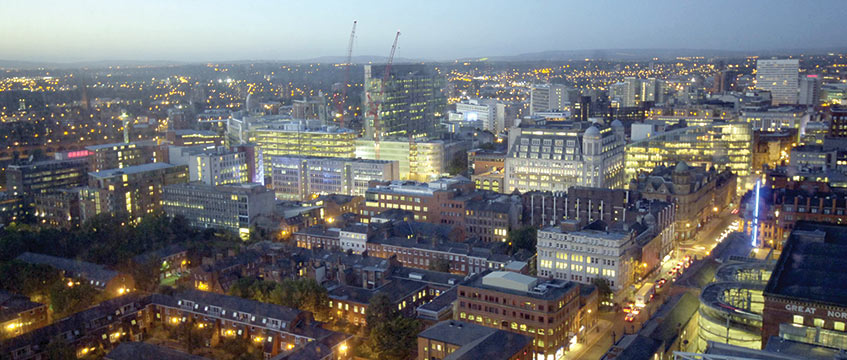UK commercial property deals could be set for a revival in 2020, with the recent lifting of the political uncertainty that has held back the market for more than three years.
Boris Johnson won a huge majority in parliament, enabling him to push through his Brexit deal at the end of January. This could give developers and investors more security around signing new deals despite the further challenges that lie ahead.
“There’s the will, the capital and the occupational demand – how that will translate into activity volumes will depend on what comes to market and what people can access, funding-wise,” says David Peck, managing director at Buccleuch Property. “This presupposes that we won’t suddenly see a dead cat bounce in terms of the Brexit effect, but personally I don’t see that.”
The sunnier business outlook has boosted projections for office rents in London while prompting industry players to prepare for a rise in investment, leasing and development activity across the country.
Headline office rents are projected to increase by 9% in London’s West End to £126.75 per sq ft by 2023 and by 12% in the City to £90.50 per sq ft by 2023.
This comes after a difficult period since the UK’s 2016 referendum on leaving the European Union. In total, investment in commercial real estate across the UK plummeted by 28% from £72.4bn in 2015 before the vote to £52.3bn in 2019, according to Savills.
By sector, retail and leisure suffered the most, with investment volumes more than halving since 2015. Industrial volumes fell by 35%, while investment into offices declined by 32%. Only alternatives remained more stable, with a 5% dip during the four-year period.
In contrast, the occupier market in London and the regions defied expectations. In central London, take-up slipped by 6% between 2015 and 2019 to 11.1m sq ft, Savills data shows, but this followed two strong years of more than 12.5m sq ft apiece. Regional cities performed even more strongly, with take-up rising by 16% over the four-year period to hit 6.7m sq ft last year.
However, Greater London and the South East suffered a 30% drop in take-up, with leasing activity slumping to just over 3m sq ft, down from 4.4m sq ft in 2015.
So given these regional differences, how will different UK markets perform this year? Will investment levels increase and will yields compress? All eyes will be on how UK city property yields perform compared to their European rivals, says Peck.
“There is no great reason why yields are so much lower in Europe relative to this country,” he says.
“Maybe financing is a bit more expensive and you can borrow more cheaply in certain other European economies but, fundamentally, places such as Edinburgh, Glasgow, Manchester or London look healthier and the property dynamics are better. That must give an opportunity.”
EG looks at three of the UK’s largest cities to understand how political uncertainty has taken its toll and what is in store for 2020.
London: the repressed beast

Having strongly voted against leaving the EU, the UK capital’s property market has endured a sharp decline in investment. In total, volumes have fallen by 12% from £19bn in 2015 to £16.7bn last year.
Retail has fared particularly badly, plummeting by 40% since 2015 to £785m but leisure has performed well, rising by nearly a quarter to £2.1bn. Office investment levels were also hit, dropping by 30% to £9.6bn over the period. Alternatives was by far the strongest sector, with investment volumes almost doubling from £1.6bn to £3.1bn.
Property investors have been depicted as hovering on the sidelines in 2019, waiting for a clearer picture to emerge. LaSalle IM’s UK chief investment officer Julian Agnew highlights the conundrum: “It has been a frustrating time. You would speak to investors and only one investor might see you due to Brexit. I think that will change this year.”
Barry Williamson, executive director of commercial real estate at Coutts, adds: “I think what we were crying out for last year was certainty. We only got that on 12 December. The timing of the election wasn’t helpful – as soon as it was called transactions going through tended to stop. For those political reasons we lost about 15-18% of the year in that back end.”
This year, the picture is a little more positive, says LaSalle IM investment strategist Simon Marx. “We are cautious,” he says. “There are some good opportunities out there but we are aware there are still some risks. One of the things in real estate we have to think about then is what risks do you then take? When you’re buying a building are you going to take leasing risk, refurbishment and development risks?”
He says London’s commercial real estate market is ripe for investment given the lack of new supply, which is keeping rental pricing strong.
“I would wager that if we had had a different result in the EU referendum we wouldn’t have had this rather constrained pipeline going forward. If you could have stopped building after June 2016, you would have stopped building. Developers would have carried on building; lenders would have carried on lending and we’d see a different outlook.
“We now have a sweet spot for the next two to three years until there’s a supply response – there will be good rental growth in London as there simply isn’t any space.”
Last year, average prime rents in the City stood at £80.70 per sq ft, up from £77.80 the year before and up by 9% from 2015. In the West End, rents jumped by 10% to £116.20 year-on-year and climbed by 5% over the four-year period.
Rents in the Thames Valley have also risen, albeit at a slightly slower pace. Since 2015, they have grown by 8% from £35.50 per sq ft to £38.50 and are projected to grow by 9% to £42 per sq ft by 2023.
But South East property agents say 2019 was a particularly tough year, with political uncertainty holding back decisions. Knight Frank national offices head Emma Goodford says: “I think, sadly, the election result was too late at the end of last year. We had the most difficult year ever, with the exception of 2009, in terms of take-up. It was a really challenging year for the market; everyone deferred decision making.”
CBRE head of offices Rob Madden adds: “The occupier market in the City and West End continued to fly last year. The Brexit debate seems to have had no marked impact on the London occupier market but in the wider South East market it is different. Last year was fine until March, when the indecision and uncertainty came back in again.”
But going forward, Goodford is more optimistic. “What feels different is the sentiment in the market; landlords and developers are dusting off plans and thinking about what they can do.
“I think we will see rental growth in the core markets of Hammersmith, Croydon, Richmond, St Albans, Watford – around 10% over the next five years. This year’s take-up was below the 10-year trend but the return to confidence should lead to more activity.”
Manchester: the comeback kid?

With increased political and economic certainty, cities such as Manchester could bounce back.
Last year though, investment volumes fell off a cliff, dropping by 78% from £2.1bn in 2018 to £541.6m. Over the four-year period from 2015 they fell by 28%.
John Hughes, managing director at north-west developer Ask Real Estate, says: “Last year the volume of transactions in Manchester fell to historical lows. A lot of the traditional funds, UK institutions or European investors were sitting on their hands and waiting to see how uncertainty would play out.”
The hardest-hit sectors year-on-year were alternatives and offices, which saw investment levels plunge by more than 80%, while leisure investment fell by 70%. The industrial market was the only exception, doubling to £114.6m.
However, the city’s occupier market has proved healthy, with take-up rising by15% from 1.3m sq ft in 2015 to 1.5m sq ft last year. Rents per sq ft have grown from £34 to £36.50 over the period.
Looking ahead, some are also hoping that prime minister Boris Johnson will make good on his promise of investing more in the regions.
As Chris Mulcahy, director at JLL, says: “I think it feels like he does want to look after the regions more than previously and we are expecting to see more inward investment over the next five years.”
Hughes adds: “There can’t be any doubt Brexit uncertainty will remain throughout this year. But for Manchester, real estate is an asset class investors still turn to in times of uncertainty. This will remain true in 2020 and beyond. If the interest rate position is lower for longer, assets like property should remain popular.”
Birmingham: the HS2 believer

Birmingham fared a little better than Manchester last year, and industry commentators are upbeat about the city’s prospects in light of prime minister Boris Johnson giving the green light to the HS2 high-speed rail project in February.
Investment volumes fell by 15% year-on-year to £976.2m but rose by 28% since 2015. Meanwhile, year-on-year take-up remained stable at 780,095 sq ft but was down on 2015’s 961,675 sq ft.
By sector, retail investment suffered, with volumes falling from £249m in 2018 to just £5.7m in 2019, with the industrial market also weakening substantially from £248.5m to £43m.
Stronger performers were alternatives, which nearly doubled year-on-year to £320.7m, and leisure, which doubled to reach £190.5m. The offices market remained broadly stable at £416.3m.
Going forward, Birmingham property agents are upbeat about the city’s prospects for 2020. Carl Potter, Birmingham managing director for Avison Young says: “Brexit uncertainty has had a huge effect on the regional investment market, with numbers down across the board. But we have already seen a pick-up. We saw a pick-up directly after the election result. That’s not because of the way it went. It’s because of the certainty created by a strong majority; we now have five years’ political certainty. Generally, we know what the route map of the government is, and it is very supportive of business.
“I also think Birmingham is exceptionally well positioned due to HS2. This is supporting occupational demand. I think we will have a strong level of office take-up in the city this year, following major announcements this year such as BT moving to Snowhill. The city is becoming more of a prelet market and others are now coming too.”











